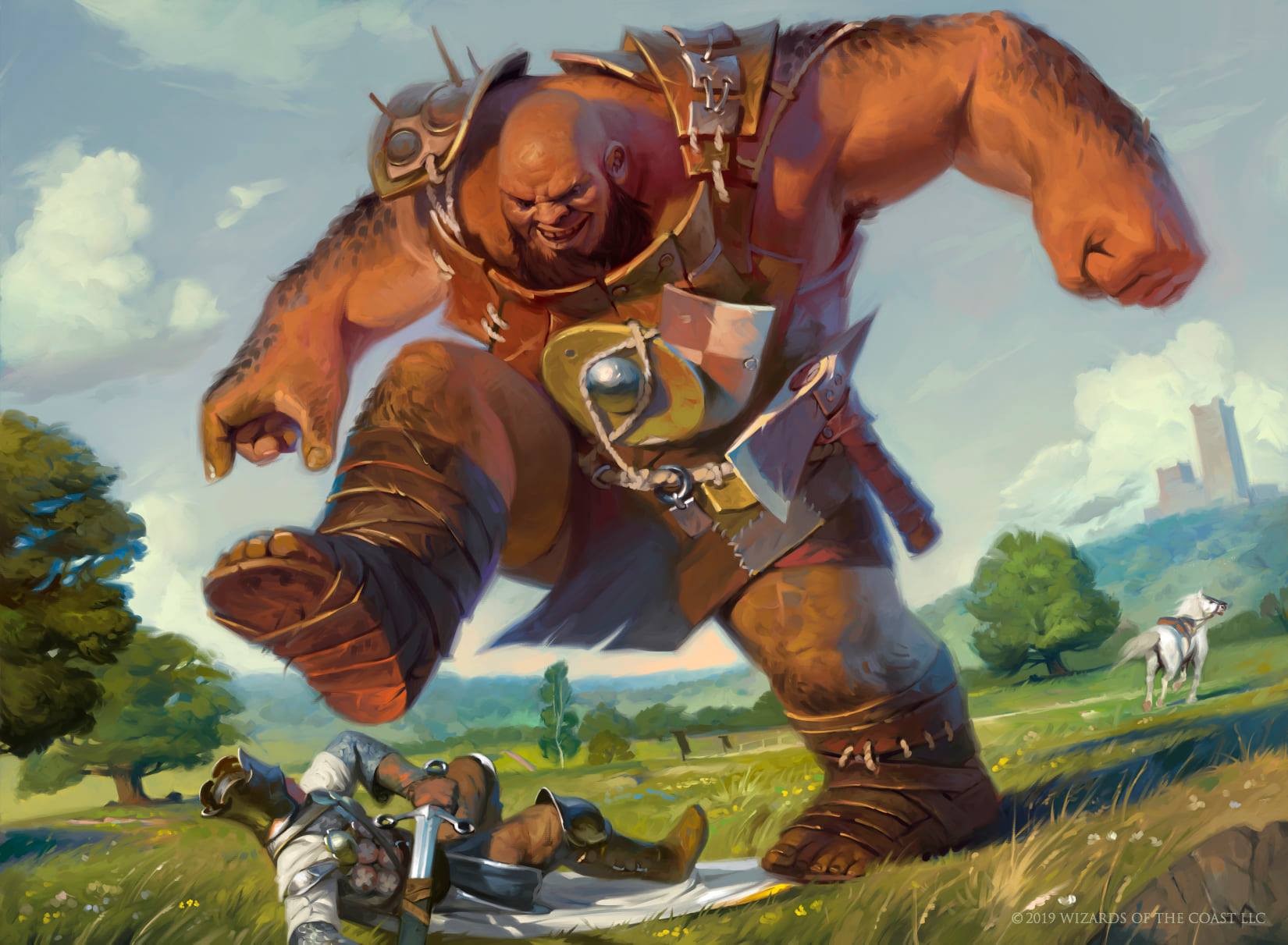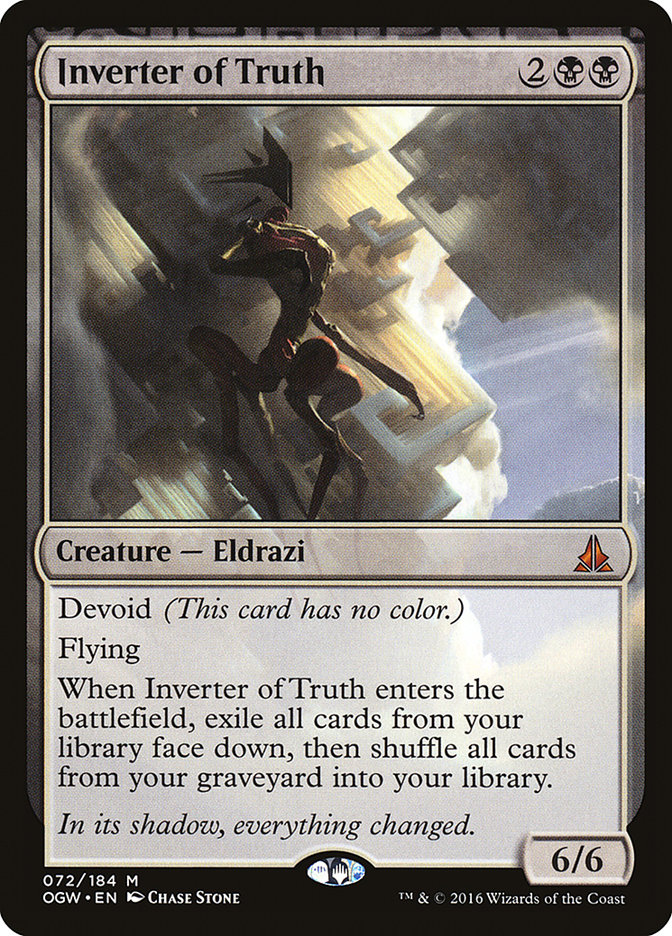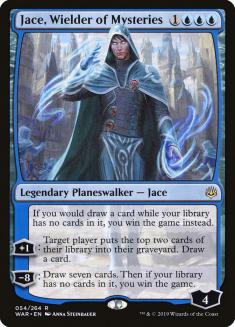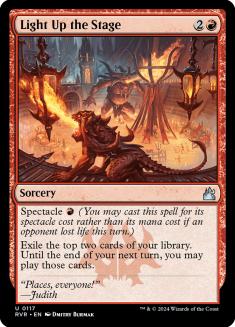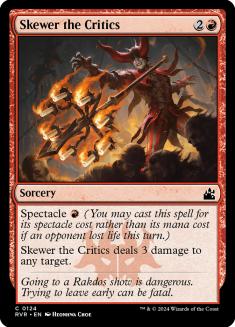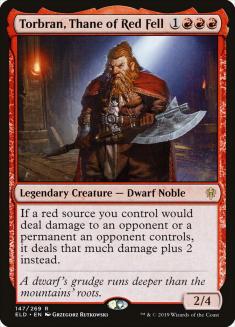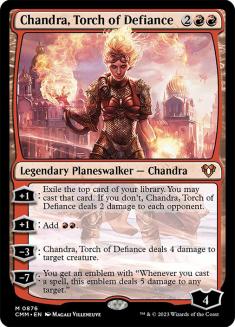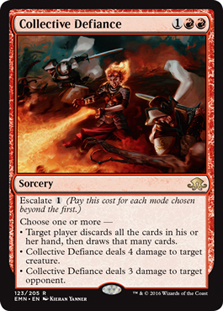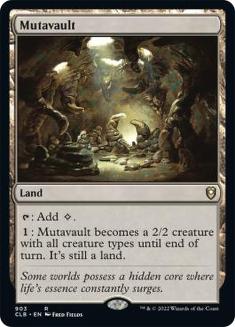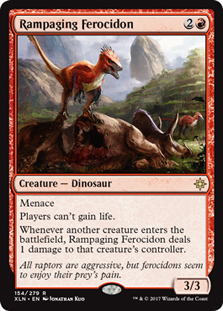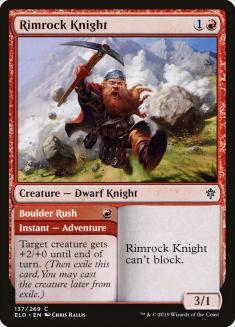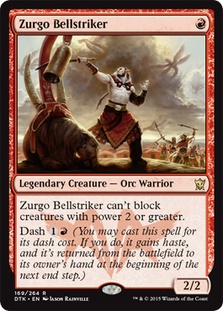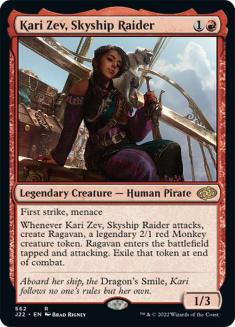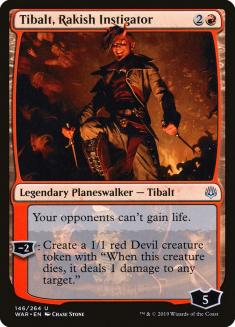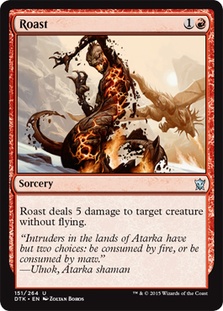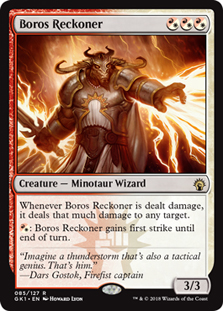I’ve done a lot of jawing recently about the existence of Dimir Inverter in Pioneer. In my humble opinion, it shouldn’t exist. The combo look and feels too much like Felidar Guardian plus Saheeli Rai, giving the opponent an “oops I win” moment on the regular while the rest of their deck plays out normally. That type of combo creates feel-bads for the opponent and new players, since it doesn’t really make sense how or why this would work or even be legal. This type of combo has been banned in Modern and Pioneer, from Splinter Twin to Felidar Guardian, so why does Dimir Inverter still exist?
But today’s article isn’t going deep into that subject. Instead, I’ll be figuring out the best way to attack this strategy while still giving you some game against the rest of the field. I’m 10-2 against Dimir Inverter since I started playing Mono-Red Aggro, with both losses coming from Turn 5 kills both games. But a Turn 5 kill on its own isn’t actually that big of a problem. The actual problem comes from how easy it is to assemble the combo, all while the rest of the deck gets to interact. This constricts the total number of turns where any decision matters, which means we have to go super-low-to-the-ground and get under that combo as best we can.
So far, Mono-Red Aggro is the only deck I’ve found that can do that successfully. Everything else is vulnerable to Thoughtseize, or even just their “Dimir Control” alternate gameplan. I can’t tell you how many times I’ve lost to Dimir Inverter after casting Unmoored Ego on Inverter of Truth. When combo decks have the ability to interact heavily and are resilient to potent disruptive elements, it makes the games nearly impossible without drastically altering the landscape of the format.
And sometimes changing the format is fine. Sometimes having a combo deck in the format is fine. I don’t want to dissuade people from playing or trying out new combo decks. But with every combo deck should come some sort of deckbuilding restriction or opportunity cost. Dimir Inverter has neither, as the combo pieces are all pretty solid on their own, and the package doesn’t require you to shape your deck entirely around it. Much like Splinter Twin and Felidar Guardian before it, you just get to play normal Magic until you end the game in one fell swoop. And thanks to the strength of cards like Thougtseize, Fatal Push, and Dig Through Time, interacting and having a payoff for that interaction is effortless.
To reiterate, my record against the deck with exactly Mono-Red Aggro is outstanding. Ten wins and two losses is an excellent percentage against the best deck in the format. But the lengths I had to go to in order to have a positive win percentage has made it so beating anything else in the format is much more difficult than usual. Still, one Red deck shouldn’t be able to beat everything easily. It’s okay to have a good combo matchup and a bad midrange matchup.
What else actually beats Dimir Inverter? If this last weekend’s Pioneer Open is any indication, nothing. With both players in the finals piloting the archetype, there’s no real argument to be made against it. Ben Wienburg and Pete Ingram were the lone 9-0s and both closed out the tournament in impressive fashion.
So how do we attack it?
Burn It Down
When first constructing this new iteration of Mono-Red Aggro, I decided that the best way to approach the matchup was to give myself a significant amount of burn spells so I could dodge spot removal as well as close the game quickly when my creatures didn’t actually die. My first inclination was to build around Wizard’s Lightning and Ghitu Lavarunner, but I just didn’t feel like we could play enough good Wizards to turn it on, so my next instinct was to replace it with Skewer the Critics. And while that burn spell isn’t exactly my favorite, it does seem to get the job done.
After brewing a bit, here’s what I ultimately came up with.
Creatures (22)
- 4 Eidolon of the Great Revel
- 4 Monastery Swiftspear
- 4 Abbot of Keral Keep
- 4 Soul-Scar Mage
- 4 Bonecrusher Giant
- 2 Torbran, Thane of Red Fell
Lands (22)
Spells (16)

In two Leagues and Day 1 of the Pioneer Open, I went 16-3 with this list. Unfortunately, the three losses were all in the Open, which meant my tournament ended abruptly. After losing in the last round to Dimir Inverter, getting Turn 5 combo-killed both games, I was pretty frustrated. I beat it three other times, but them having the “oops I win” combo after killing my first three creatures is just exhausting. But let’s talk about the things this version did right.
The idea here is that the eight prowess creatures on the first turn allow for high damage output with both Skewer the Critics and Light Up the Stage, assuming you can throw a different burn spell at your opponent before combat. The low-ish land count combined with Light Up the Stage allows you to cast Torbran, Thane of Red Fell on curve regularly without flooding too badly.
Skewer the Critics is one of my least favorite “good” burn spells because it’s pretty difficult to kill a medium-sized creature with it when you’re trying to get in some attack damage. But that, of course, is the entire tension built into the card. It has high damage output for low mana investment if you can cast it after dealing some damage, but it should be actively difficult to have Lightning Bolt in your deck! Still, when your opponent isn’t killing your creatures or putting up a lot of blockers, Skewer the Critics is one of the most efficient burn spells in your entire arsenal. And if you’re trying to close games quickly, Skewer the Critics is high on the list of cards you want to play.
But constructing your deck to be built around those prowess creatures, having a lot of burn spells and such, means you can be relatively vulnerable to lifegain effects like Uro, Titan of Nature’s Wrath. You need your creatures to do a lot of heavy lifting in those matchups, but having fewer means you’re susceptible to strategies that deploy both removal and lifegain effects.
I will say that I did win every game except for one where I got to untap with Torbran, Thane of Red Fell. Often I would deal over ten damage on the follow-up turn thanks to the heavy amount of burn in this version. While you don’t have the token generators that work well with Torbran, the burn aspect is pretty nice! With that said, Torbran did die a lot without accruing any value.
Playing this version, some games felt unwinnable. But then I’d draw Torbran and everything would change. The damage output available with a single turn having Torbran is outrageous, and one easy way to overpower something as strong as Uro, Titan of Nature’s Wrath. But I found myself sideboarding in Chandra, Torch of Defiance every round, and having it be one of my best cards nearly every single time. The breakthrough moment was having it be stellar against Dimir Inverter.
Overall, I felt like this deck was lacking something. I liked it a lot, but I also wanted to try out some new stuff in the Classic the next day. The day before, I cut Collective Defiance from my deck at the last minute, and it’s something I’ve wanted to try for a while. It’s a bit mana intensive to be great, but I felt like it was versatile enough to justify a couple of slots.
My record against Dimir Inverter in the Classic was 3-1, with my last loss of the day being another “double combo killed on Turn 5 with a few removal spells tossed in for good measure.” It was frustrating to play against, but my testing process and logic behind how I approach the matchup made a lot of sense to me. At some point, I stopped caring about losing to the combo and just put as much pressure on the table as possible. When I did that, and started treating it like a control deck instead of a combo deck, my win percentage increased dramatically.
I don’t have the exact decklist at my disposal, but here’s my closest approximation of the version I played on Sunday.
Creatures (22)
- 4 Eidolon of the Great Revel
- 4 Monastery Swiftspear
- 4 Soul-Scar Mage
- 4 Rampaging Ferocidon
- 4 Bonecrusher Giant
- 2 Torbran, Thane of Red Fell
Planeswalkers (3)
Lands (24)
Spells (11)
Sideboard

The maindeck here was solid, but a little too expensive. I had a lot of draws that featured one-land openers with a ton of stuff to do with that one land, only to draw three- and four-drop cards while I floundered and died. I treated it more like an all-in strategy instead of what it was: a bit more midrange. Unfortunately, I went 4-3 and three of those wins were against Dimir Inverter, so I didn’t increase my win percentage in the matchup much and it overall felt a bit worse against the field.
I can chalk up some of my losses on the weekend to keeping a few sketchy hands, but I also think many of those keeps were correct. It takes fortitude to make the hard choice and then keep making it when it doesn’t pan out the first time. But there’s a fine line between being right and being stubborn, so I’ll just say that I need to mulligan more aggressively for hands that curve out rather than hands that need to draw a land or two to curve out. Those types of hands scale poorly if you miss even one land drop.
What I did find out about this version is that I want to play three copies of Chandra in my maindeck, and I might even want a fourth. It was stellar. When I cast it on-curve, I killed their blocker and got in huge damage. When I drew it on an empty battlefield, I just clowned my opponent with card advantage. But it does come at a steep cost for an aggressive deck: getting stuck in your hand on occasion. Because of this, I decided to cut Torbran moving forward, putting all of my focus on the much more reliable Chandra, Torch of Defiance.
Collective Defiance was not my idea, but it is certainly a sweet one. The fact that you can force your opponent to discard their hand and draw that many cards means you get some free wins against Dimir Inverter on occasion. Additionally, being able to deal four damage to an opposing creature is nice, as red decks tend to stall out against creatures with higher than three toughness. And if you get to the late-game, discarding extra lands while killing an opposing creature or dealing some dome damage is huge.
After sideboard, most or all of your Dimir Inverter opponents will cut their discard or at least Thoughtseize. That means Collective Defiance will almost always hit and kill them on the spot. If they try to play around it, they’ll often die to your immense pressure. If they don’t play around it, peeling one or just having one at the ready means you have a lot of their combo-kills covered.
In some ways, adding two lands to the deck in the form of Mutavault made the flooding very real. But it also gave me something to do when I was flooding, as Mutavault is one of the better lands for helping you utilize extra mana. Mutavault is also great at helping you finish off planeswalkers or keep applying pressure without becoming vulnerable to a sweeper. Overall, I enjoyed this addition to the deck, and when you’re increasing your curve by adding Collective Defiance and more four-drops, having those extra lands is sweet.
But adding Mutavault also makes it harder to play triple red cards. I’m not convinced that Goblin Chainwhirler is bad right now, and Boros Reckoner was an absolute house out of the sideboard. It also makes casting Eidolon of the Great Revel a bit tougher, but the tradeoff is pretty cool. Maybe instead of four Mutavault, we can just play one or two as we up the land count.
With a rise in Bant Spirits and the ability to kill Jace, Wielder of Mysteries for two mana, Fry has gained a lot of traction over the last week or two. While it seems like an obvious inclusion, many of you know how much I hate Fry, since it just doesn’t seem to kill anything you need it to. The running joke was that it didn’t kill Oko, so what was even the point? But it seems solid right now so I’m giving it another chance.
Adding lands like Mutavault also makes it more desirable to play three-drops. After sideboarding in Rampaging Ferodicon most matches, I felt like it just deserves maindeck consideration. Like Chandra, Torch of Defiance, it felt pretty good against Dimir Inverter even though that doesn’t make a lot of sense, but it dodges Fatal Push sometimes and makes it hard for them to block or cast their combo creatures.
I like Rampaging Ferocidon a lot right now, as the main way people are attacking you is stuff like Heliod or Uro or Courser of Kruphix. It hits hard while dealing some chip damage. Huge fan.
When I got home, I started trying out a few more iterations. Here’s the latest one I’ve been pretty happy with.
Creatures (27)
- 4 Eidolon of the Great Revel
- 4 Monastery Swiftspear
- 1 Zurgo Bellstriker
- 2 Kari Zev, Skyship Raider
- 4 Soul-Scar Mage
- 4 Rampaging Ferocidon
- 4 Bonecrusher Giant
- 4 Rimrock Knight
Planeswalkers (3)
Lands (22)
Spells (8)
Sideboard

So far, my record with this version is 8-2, with a 3-1 overall record against Dimir Inverter. The ability to apply pressure early and keep it going with the extra Adventure creatures is nice, but not having Collective Defiance makes it harder to interact with the actual combo. Perhaps there is a middle ground somewhere.
This is one of the cooler additions to the archetype, powering up prowess while also giving you a higher threat density. Adventure is quite the mechanic for this archetype, as it gives you those prowess buffs without taking away from your overall threat count. The pump effect helps your small creatures like Kari Zev, Skyship Raider deal some extra damage when blocked, and really gives your opponent headaches when you factor in how annoying it already is trying to block those early one-drop threats.
Rimrock Knight is a hot one, but I don’t know if we need four. I think trimming one or two could certainly be okay.
This one was just me looking for another one-drop to play, and Zurgo Bellstriker felt like the best one. If you only play one, the legendary clause doesn’t matter, and then the card is actually quite good. A two-power creature for one mana is rare in red, and this one specifically has the ability to be a fine topdeck as the game progresses thanks to dash.
There is obvious tension between Kari Zev and Rampaging Ferocidon, but I don’t think that matters much. There’s a chance I cut Kari Zev at some point, but it’s been fine so far. I always liked it in Chonky Red, as it dodged Stomp and Wild Slash while providing you with a hard-hitting threat that was tough to block. Here, it gets lost in the fold sometimes, but it’s still decent.
When moving Rampaging Ferocidon to the maindeck, I felt a need for more of that effect. Tibalt, Rakish Instigator is solid against Sultai Midrange, but it can come in against a variety of opponents, even if they aren’t gaining life. The ability to generate two threats for a single card, and moreover threats that can potentially kill two creatures, is pretty sweet. It makes spot removal worse, which I love, but just having more of the “opponent can’t gain life” effect is dope.
Many of you haven’t played against Simic Eldrazi or seen it in a while, but it’s starting to run rampant on Magic Online thanks to it winning the most recent Pioneer Challenge. Roast helps fight Lovestruck Beast, but exiling the opposing creature just doesn’t matter much right now. That means Lava Coil is less valuable. And while Roast can’t kill a flying creature out of Bant Spirits, having sorcery-speed removal like Lava Coil isn’t all that valuable anyway. Perhaps we could play a combination of both, as I’m inclined to cut Damping Sphere since we have both Scab-Clan Berserker and Eidolon of the Great Revel to punish those decks.
Just an outrageous threat against decks with lots of creatures and little hard removal. It’s basically impossible to block and impossible to attack into. If they kill it with fire, they’re likely taking a ton of damage themselves or you’re killing one of their creatures. Boros Reckoner singlehandedly won me a lot of games over the last week.
Burn’s Metagame Position
Red decks tend to be good against combo in general, but often struggle in a format where everyone knows you’re the best deck. Right now, we might be in a sweet spot where you lose against exactly Uro but you can build your deck to be great against opponents playing just about everything else. It just depends on what you want to focus on at any given moment. And at the moment, I’m focusing on beating Dimir Inverter, and my results have been exceptional against the archetype.
With all of these decks, I’m a combined 10-2 against the best deck in the format. My overall record is still really strong, even if I didn’t spike the Pioneer Classic or Open. I have two 5-0 trophies in Leagues and a lot of 4-1 finishes. I like all three builds for different reasons, but the best iteration likely combines some of the best elements of all three into one perfect amalgamation. I’m looking forward to playing more with these Red decks as the Pioneer metagame continues to evolve to fight the menace that is Dimir Inverter.
Before I go, I just wanted to give a huge shout-out to Aaron Barich. We talked a bit on Twitter and between rounds all weekend about potential changes to the deck, as well as theorycrafting future builds. Working with her was a delight, and I highly recommend following her on Twitter or Twitch if you are interested in this type of strategy.

